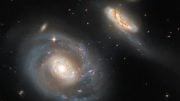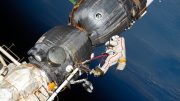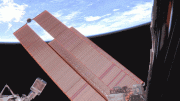A sample of polymethyl methacrylate, also known as Plexiglas, was burned in the Saffire-V experiment. Ribs were manufactured into the material to see how the flame behaved when small structures were incorporated into larger materials. Researchers discovered that fires in microgravity typically grow and burn faster on the thinner ribs and materials as opposed to thicker samples on the right. Credit: NASA Glenn Research Center
Our understanding of the way fire behaves in space is expanding as the fifth in a series of NASA investigations ignited recently. The Spacecraft Fire Safety Experiment-V (Saffire-V) successfully tested larger, more dynamic fires for over 26 hours inside Northrop Grumman’s Cygnus spacecraft, following its primary mission of delivering supplies to the International Space Station.
After Cygnus departed the station on January 6, operators on the ground, for the first time on a Saffire mission, lowered the pressure inside the spacecraft and backfilled it with oxygen to replicate potential atmospheric conditions that would likely be experienced inside future human spacecraft.
After ignition, cameras and sensors monitored flame growth, temperature variations, and oxygen changes, which were translated into data. The data will be used to model fire response scenarios, as well as fire detection, combustion product monitoring, and post-fire cleanup.
“The elevated oxygen levels show more energetic flames, which would have a larger impact on the vehicle,” says Gary A. Ruff, Saffire project manager at NASA’s Glenn Research Center in Cleveland. “The Saffire-V data will allow us to model fire scenarios and increase our confidence in safety strategies.”
Another Saffire experiment is ready to fly on an upcoming launch to the space station as NASA continues to pursue a greater understanding of the risks and behaviors of fire in space for Artemis astronauts who will explore the Moon and eventually Mars.
Saffire is a series of experiments developed by the Spacecraft Fire Safety Demonstration Project which supports NASA’s Exploration Capabilities Program.









Interesting.
Q. What are the components of what Prometheus stole from the Gods?
Q. What are the requirements for creating Fire , whether is Space or on any Planet? How many different types of fires are there ? Are they classified systematically as we have classified the elements and the compenents of the trace elements that burn toproduce heat and light?
Q. what is the Output of such Fires and can the same be used in Deeep Space to eliminate the Risk of Fire altogether and future Spacecraftis Risk Free?
Q. What is the engineering required to create such a virtuous cycle to make future space crafts completely fire proof?
Unwillingness to ask searching questions and find answers without any biases, is the bane plaguing humanity! I am a votary for Basic Research. AND Devopment based of such questioning and findings and answers. Tinkeing (Engineering ) will help us in getting things done . But Knowledge will give us clues, and understanding to how to apply the same in creation of new technologies.
Q . What role does Temperature and Pressure play in creation of Heat and Light we can observe using our gross sense of Sight and Touch?
The Vision is best ennunciated by the Visionaries . who can see both the big picture as well as the unseen. Macro, Micro, Nano, Gross and Invisible.
The sense of Sight and touch is only one of the Five Gross senses. Vision is what is best depicted by Atists paintings , Sculptures created by humans from a piece of Stone frozen over from Past Vlcanoes. Sometimes , when we get too involved in the Nano we are unable to see the Big Picture and vice versa. This is critical for Humanity’s progress.
Reconciling the Micros with the Mactro and making sense of the same is required. The tools are Mathematics, Physics and Chemistry AND Biology . Biology is the Science where understanding and progress is barely understood and we have not understood the same sufficiently and ignore the outcomes of the impact of the same on Creation.
Newton was not wrong when he said that for every action there is a equal and opposite reaction.
Views expressed are Personal and not binding on anyone.